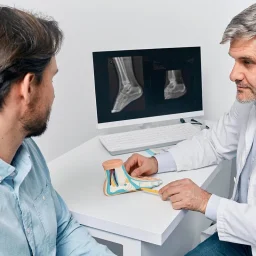
A lot of us dread going to the doctor, no matter the kind. The process of scheduling a podiatrist appointment rarely comes to mind unless are in extreme pain or have a lack of mobility impedes our daily workflow. We put off going to the dentist, getting a check-up and everything else in between for as long as we possibly can, but in the end, we are just doing more harm to ourselves.
When it comes to your feet, you really shouldn’t wait to see your podiatrist if you’re experiencing a problem. Something small which can be fixed with conservative methods can easily become a major problem requiring a more invasive remedy if left untreated.
While some problems, like an ankle sprain or foot wound, will go away with some at-home TLC, it is important to monitor your condition. If the issue of concern gets worse or fails to heal, your podiatrist can provide you with the right diagnosis and treatment plan to get you back on your feet, pain-free.
Here are 5 signs you should see your podiatrist:
Persistent Ankle Joint Pain
Ankle joint pain can be a sign of arthritis, one of the most common conditions Americans suffer from. If you notice your ankle joints are swollen, tender, stiff, red or warm to the touch, you should schedule an appointment with your podiatrist. He or she can recommend treatment options to reduce joint inflammation, pain and stiffness.
Diabetic Foot Care
For patients with diabetes, it is extremely important to see your podiatrist regularly. Diabetes can affect the blood flow to your lower extremities, reducing sensation and making it harder for infections to heal. In addition to seeing your podiatrist for habitual check-ups, you should also check your feet daily for any developing problems or reduced sensitivity.
Ingrown Toenail Treatment
An ingrown toenail is a painful, but common, occurring condition for most people. While some home treatments may be successful, it is better to see a podiatrist who can safely remove the ingrown nail and provide medication to prevent infection.
Numbness or Decreased Sensation
Persistent numbness or decreased sensation in your lower extremities is not something to ignore. These symptoms could be signs of an underlying condition that needs to be addressed, such as a fracture or tendinitis. Numbness can also be a sign of neuropathy, or damaged nerves, which is a condition diabetics are particularly susceptible to.
Pain When Walking or During Normal Activity
You should not be experiencing pain when you walk or during normal day-to-day activities. If you are, you should see your doctor to address the possibility of an injury that did not properly heal. Without treatment, your condition could get worse and you may have even more difficulties completing your normal activities.
No matter the foot or ankle condition, it is important to be vigilant and have your podiatrist properly diagnose your problem. At Certified Foot and Ankle Specialists, we have several South Florida locations from Ft. Lauderdale to Palm City to address and treat all of your lower extremity conditions.
Schedule an appointment with one of our board-certified podiatrists today! 1-855-550-FEET














